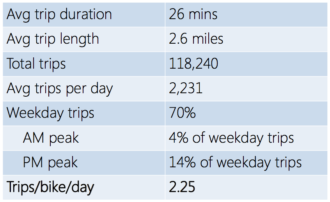 Free-floating bike share is working in Seattle. Or at least it sure appears that way according to the city’s first analysis of anonymized private bike share data.
Free-floating bike share is working in Seattle. Or at least it sure appears that way according to the city’s first analysis of anonymized private bike share data.
In just two months, people have already taken 120,000 trips on the bikes. And because companies are steadily increasing the number of bikes on the streets, the number of rides each day continues to grow at a steep rate. 6,000 bikes are currently permitted, but SDOT’s Kyle Rowe told the Committee that he estimates the actual number on the ground now is closer to 4,000 and increasingly daily.
In fact, as bike share companies add bikes to Seattle streets, the number of rides per bike per day has increased, as well. This is a big deal, since the business model for free-floating bike share is essentially dependent on this virtuous cycle in which adding more bikes leads to each bike carrying more trips and making more money.
This is good for Seattle, since it gives companies a clear incentive to keep adding more service to the city. And, of course, it’s a good thing for the companies who need to make money to stay in operation and keep expanding. At what point will adding more bikes fail to further increase ridership? Nobody knows. But we likely have a long way to go before we reach that saturation point.
SDOT officials presented (PDF, video) the City Council’s Transportation and Sustainability Committee with a first look at two months of bike share activity in the city, based on data companies are required to report as a condition of the permit. The data adds LimeBike, Spin and ofo information together to look at the sector in general without exposing individual company operations.
The graphs they showed were astounding. Here’s the growth in rides per day:
That is a very steep climb.
Here’s the rides per bike per day:
It’s hard to know how these numbers truly compare to other bike share systems because they only represent warm summer months and the number of bikes kept growing throughout the study period. But if the average can stay in the 2.25 range (the red line) over the course of a year, Seattle bike share use will be second in the nation behind only Citibike’s 3.6 rides per bike per day (Capital Bikeshare in DC and Hubway in Boston see about 2.1 rides per bike per day). If the trend continues growing as more and more bikes are added, Seattle could start writing new standards for bike share use in the nation.
Of course, Seattle’s not alone in this free-floating bike share game. Mobike (a China-based bike share giant that rivals ofo), Spin and LimeBike are in the process of launching in Washington DC as I write this. That’s a big deal because, unlike Seattle and Dallas, DC already has a successful station-based system. The whole industry will obviously be watching what happens there closely.
There are still many tests ahead for Seattle’s bike share services. The rains have arrived big time in recent days, and you would expect bike use to dip through the winter. Bike maintenance needs will also likely increase in wet weather (especially if the city ends up salting roads due to freezing weather). But the cap on bike numbers is set to lift October 7, so companies could start adding bikes at whatever rate they see fit. There could be forces pulling bike use in both directions.
The cool thing about these bike share services is that you don’t have to bike in heavy rain if you don’t want to. Let’s say you take the bus to work because it is raining, but weather clears up by the time you are off work. Bike share is waiting there for you. I bet we’ll start seeing a lot of mixed travel based on weather conditions. That’s why having many transportation options is so great.
In a city where traffic only gets worse, bike share is taking real and immediate action to do something about it. And it appears to be working.
Spin releases new, vastly-improved bikes
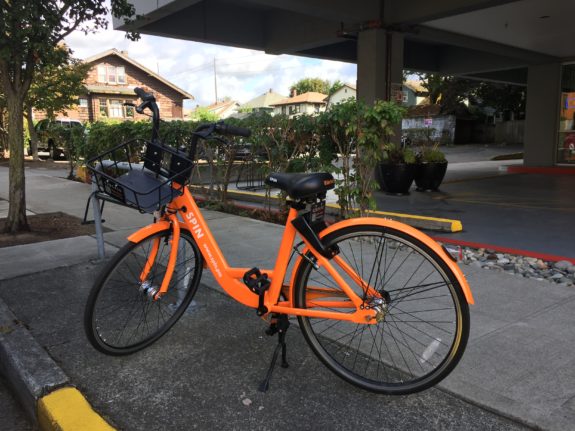 Until now, LimeBike’s very low gearing and general sturdiness gave that company’s bikes an advantage over Spin when climbing Seattle’s hills. But that may have changed in the past week or so, because Spin has launched a new and vastly-improved bike. It is lighter, has a lower low gear, a better shifter, stronger brakes, a better kickstand, a locked seat post that does not swivel and is harder to steal, and a much better headlight.
Until now, LimeBike’s very low gearing and general sturdiness gave that company’s bikes an advantage over Spin when climbing Seattle’s hills. But that may have changed in the past week or so, because Spin has launched a new and vastly-improved bike. It is lighter, has a lower low gear, a better shifter, stronger brakes, a better kickstand, a locked seat post that does not swivel and is harder to steal, and a much better headlight.
In fact, the new Spin bike passed an informal test I have used to gauge each company’s bikes: I was able to climb up Pine Street from downtown to Cal Anderson Park without standing up to pedal. Before now, only LimeBike had passed this test.
Right now, Spin’s fleet is a mix of the old and new bikes, but the company is gradually phasing these bikes into the Seattle market. The easiest way to tell if it’s the new bike is that the kickstand is a double-stand style and the front basket moves with the handlebars instead of being attached to the frame. Give it a try and let us know what you think in the comments below.
Forbes says LimeBike is now worth $200 million
Meanwhile, LimeBike announced this week that as the company keeps deploying more bikes on its way to the 2,000 max allowed, the company will focus specifically on underserved areas: “With this increased deployment, LimeBike will focus on underserved areas such as Rainier Valley and South Delridge, to make transportation easier and more accessible,” the company wrote in a press release.
This goal is in line with something SDOT Transit and Mobility Director Andrew Glass Hastings said during the Council briefing: “Transportation remains the second overall household cost” in Seattle. And while SDOT can’t do a whole lot about rent and mortgage payments, “we can directly lower the cost of transportation.” And $1 bike share is part of that effort.
The use map at the top of this post shows solid use in Rainier Valley, which is impressive considering the lack of consistent and connected bike lanes there. Just imagine what use would look like if there were bike lanes on Rainier Ave.
LimeBike recently closed a second round of investment funding in the “tens of millions,” Forbes reports citing “one source familiar with the deal.” The latest round values the nine-month-old company around $200 million, the Forbes report adds.
Firms involved declined to comment publicly on these figures, but if it’s true, that could put LimeBike in a position to compete with China-based companies like Mobike and ofo that have hundreds of millions in funding on hand, valuations in the $2 billion range and business growth strategies of global proportions.
Grace Lin, VP of ofo U.S., told Seattle Bike Blog that her company’s goal is “to unlock every corner of the world, and to make bicycles accessible to anyone, anytime, anywhere.”
This free-floating bike share thing is just getting started.

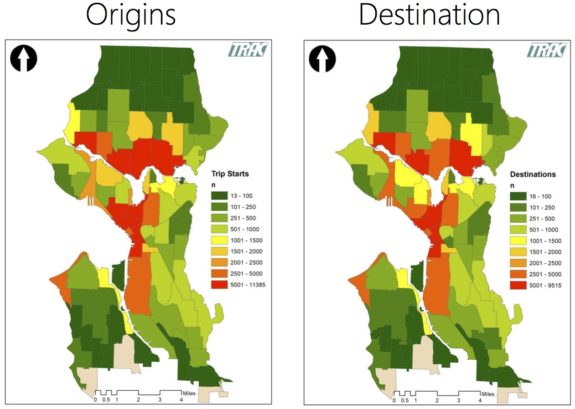
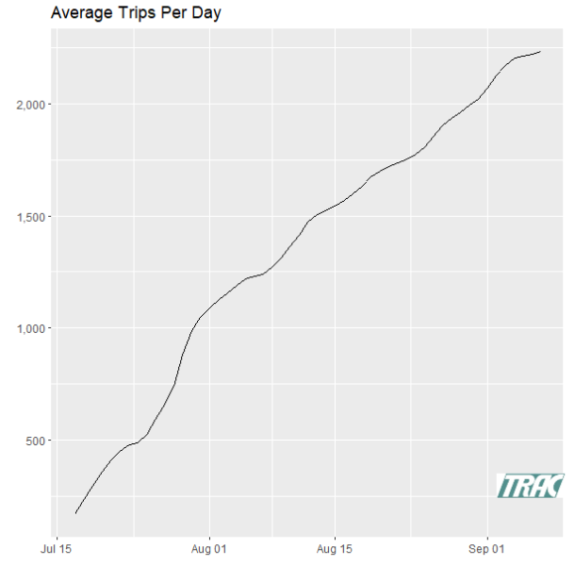
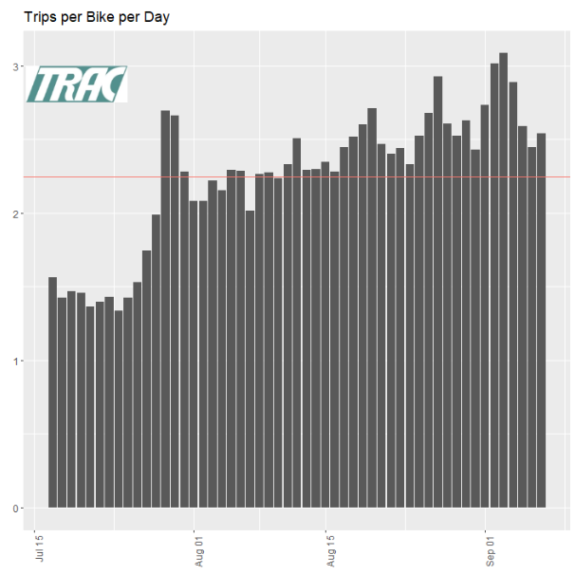







Comments
32 responses to “Bike share ridership is booming + Spin launches better bike, Forbes says LimeBike valued at $200M”
The 2.25 trips/bike/day number seems to be an error (much too high). As of early September, the charts show:
2,500 total trips per day
——-
4,000 bikes deployed
= 0.625 trips per bike per day.
That’s about 1/4 of the stated number. Am I missing something? Maybe they are excluding any bike that had 0 rides or was “reserved”, though for that to explain it, would mean 3 out of 4 bikes aren’t ridden at all.
The data ends before the cap was raised to 2,000 per company (happened Sept 7, but as we reported the companies did not immediately rush to 2,000). But even if there were only 2,000 bikes at the time, that’s still not 2 rides per bike per day. Hmm. I’ll ask about this.
Oh, I think I see now how they got 2,231 total rides per day– it’s not a moving average, it’s a program lifetime average! They average over the whole duration of their data which I guess is 53 days (then 118,240/53 =2231).
To rationalize the 2.25 rides per bike per day, that then would imply, over the life of the program so far, there averaged about 1,000 bikes in service any given day. Which still seems a bit lower than I’d have thought, but not off by a factor of 4, since as you said they only just got up to 4,000.
The other implication is that average total rides per day number is gonna keep climbing for a while as more months of multi-thousand bike data get folded into the average.
Thanks Tom!
I think the number of actually available bikes at any one time is much less than the advertised maximum numbers. The data in this post equates to an average of 992 bikes in service over the period (avg 2231 rides/day divided by 2.25 rides/bike/day). Now, the period started with only 500 Limebikes, and the next week Spin started ramping up distribution. But it seems the total number of bikes did not reach the maximum of 3,000 prior to 9/7.
For myself, I find a *lot* of bikes downtown that refuse to unlock, giving a response that the bike is “under maintenance” or not available. These out of service bikes may be dragging down the numbers.
JTinWS, you’re right on how they got 2.25. From Alan Bassok, who worked on the data:
“Total bikes on street at end of data for the graphs is around 2,200 for all three companies. For most of the period of time discussed the number is far lower. See the graph with the horizontal red line across at 2.25.
For each day, trips / bikes = bpd
For entire time period, bpd/53. (Average bpd)
So can’t go back to 2,200*2.25 and get to 4,950 trips. “
Is there a way to get a color-blind-friendly version of the map? I can’t tell the two extremes apart.
Have you tried Chrome Daltonize? It can do on-the-fly color blindness compensation for web pages and images.
https://chrome.google.com/webstore/detail/chrome-daltonize/efeladnkafmoofnbagdbfaieabmejfcf
Thanks! That worked like a charm.
While these numbers are encouraging, the number to compare for Citibike is their summer average, which is about 6 rides/bike/day.
https://www.citibikenyc.com/system-data/operating-reports
The metric of rides per bike per day is obsolete – it comes from a mentality of scarcity – “we can’t afford more bikes, so we have to maximize the use of what we have.”
Without docks, your effective cost per bike is much lower, so bicycle quantity is not as much a limiting factor. Redundancy is part of the dockless appeal.
2.25 rides per bike * 5000 bikes / ~700k population = ~16 rides per 1k people Seattle
The equivalent figure for NYC is about 6 rides per 1k people.
So dockless in Seattle is doing around double Citibike already, on a per capita basis. The real culprit there is that Citibike is vastly underbuilt due to city obstruction.
Cliffs: Rides per capita > Rides per bike.
I totally agree — rides per bike is only a good metric when scarcity/cost of bikes is an issue. When you have zillions of cheap bikes scattered all around, of course the number of rides per bike will go down, but it doesn’t matter. It’s all about rides per capita (i.e., per person).
So when you say no cap on total number of bikes starting on October 7th, that really means they can put out as many as they want to?
I think the public will rebel a bit if the streets get too cluttered. I saw on twitter an angry cyclist dad with child who collided with some parked along/in a park pathway.
Hopefully there is some oversight and control to avoid http://www.abc.net.au/news/2017-05-21/chinas-oversupply-of-shared-bikes-clogging-up-city-streets/8543720 etc.
I totally get the frustration, but I’m also just taking the opportunity to enjoy for a small moment the problem of having too many bikes. :)
Perhaps bikes should be allowed to park on the street like cars that get free parking.
As you wrote in the article, the key question is what happens when the rains arrive. Warm dry weather isn’t the norm for much of the year. I’m very concerned ridership will drop, maintenance and vandalism will rise, and the businesses will struggle.
I’d add that there’s still the two legal problems, the businesses encouraging widespread violations of helmet laws and rampant illegal parking of the bikes, that have to be handled.
I do like bike shares, but I also think it’s going to be hard to make them economically viable in wet and hilly Seattle. We’ll see. This winter will be a good test.
The hills don’t really matter, as long as the bikes get enough use out of the Burke-Gilman, and other flat routes to justify their existence.
Rain, we’ll just have to see. I’m not too worried, as, in spite of our reputation, it doesn’t rain all day every day. Even on rainy days, people who bus to work in the pouring rain might still ride bikeshare back if the rain lets up before evening commute.
Personally, I think the rain is the best thing about the bikeshare program. I can’t tell you how many times I’ve taken the bus to work, instead of riding my own bike, on a rainy morning and found myself severally regretting that decision in the evening as the bus was snarled in traffic and delayed over 30min. I plan on using bike share significantly more this winter. I don’t want to say that ridership will be up from the summer but I don’t think the drop off is going to be as severe as many people, understandably, fear.
This is really just a matter of how the public views biking. Hills and rain are not de facto barriers that will destroy bikeshare. However, if the non cycling public believes that is true and doesn’t learn how to use bikeshare, this could be a self fulfilling prophecy.
Actually, bike share outperforms private bikes when it comes to picking your battles, riding only when you don’t have to go up hills or in the rain if you don’t want to. If anything bike share could have broader appeal compared to owning your own bike, especially with the scourge of bike theft, lack of all ages and abilities safe places to ride and expense of buying a new bike. All these factors make it hard for many to find the opportunities, time or money to ride.
Go down to Golden Gardens or Green Lake or the Burke-Gilman and you will see people riding bike share bikes who would never have otherwise biked to these places. Similarly, folks who will ride on Westlake but won’t ride downtown can simply leave the bike when they get to unsafe or uncomfortable conditions. Seattle might not be a perfect bike city, but that could actually make it a particularly nice bike share city, if people learn how to use it.
Has anyone seen the upgraded Lime Bikes with the longer seat posts yet? If so, how much longer are the posts, and is there an easy way to identify those bikes?
So far, only the Spin bikes have been tall enough for me. I’m glad to hear they fixed the gearing as that was the only thing holding me back from using them regularly.
Some stuff that’s interesting to me:
1. Usage drops off dramatically north of Green Lake, apparently more than on the far south end of the city. Maybe the commercial areas up there are more thoroughly auto-centric than those in the Rainier Valley and on Beacon Hill? Maybe there aren’t the same last-mile-to-transit needs (the south end has Link, the north end has more closely-spaced express transit)?
2. The reddish area south of downtown… looks like it covers the baseball but not the football stadium, and goes south from there, between I-5 and the Duwamish, stopping just short of the residential part of Georgetown? It gets a lot of use for an area with almost no bike infra.
A lot of the drop-off north of Green Lake probably has to do with terrain. You can’t ride north from Green Lake without going up a hill, nor can you ride down without somebody else riding the bike up.
The map also reflects the initial seeding in Fremont and downtown, and migration from there. Rainier valley will probably be a lot more dense with the next round of seeding there. Wonder what the north would look like if there was an effort in Greenwood.
I agree, this is a combination of terrain and seeding in the North of Seattle. I’ve tried Lime for last-mile-to-transit, and with the low seat post I need to make an all-out effort to get to the express bus or the nearest stores. Most practical rides have a 100 or 200 foot elevation gain. Spin’s seat post is high enough for me, but the original gearing negates that advantage. The bikes are still very few and far between in the area, so unless there’s one right there when I just missed a bus, it’s not a great trade-off. That said, I have seen them in use and I’m looking forward to more bikes, and it seems like the companies are all working on improving the bikes’ performance.
Some thoughts and some questions:
The usage along the Burke really tells us how bad Pronto’s business model was. Of course, these companies haven’t yet experienced what happens when your bike has been sitting in the rain for three days, so the other big Pronto mistake (launching at this point in the year) is unknown as to how it will affect them.
Between Ofo, Lime and Spin, the one whose app shows which model bike is in a location will get my business. I once located the only Ofo near UW station only to find it had a smaller seatpost than my prior Ofo ride, and having already rented it, was sort of stuck. It’s great to shop when the bikes are thick on the ground, but where they aren’t and you really need a bike, finding one of the older, worse models is the only one available, or that you could have turned left to the good one when you instead turned right for the bad one, is not going to make for happy customers. Particularly, following up on the idea of biking home when it clears at night; finding the wrong bike in the dark is going to be a problem. Dark: Seattle’s evening commute from September to May.
[…] Seattle Bike Blog , Curbed, and NextCity cover the apparent success of private bike-share companies permitted to operate in Seattle. […]
[…] critical mass in certain neighborhoods. In two months, the average total trips per day went from zero to 2,500, and according to data from The Market Urbanism Report, the company had more daily rides per bike […]
I was planning on using Lime Bike on my next trip to Seattle but just discovered that their app needs at least iOS 10 to run. I’m still on iOS 9 (and have no reason to upgrade just yet) so that leaves the other guys.
Spin and ofo’s apps work even on iOS 8. Guess I’ll go with them then.
Having commuted on an internal-gear bike with chainguard and fenders through more Northwet winters than I care to count, I doubt winter weather will really have much impact on maintenance needs.
Oil the chain every few thousand miles whether it needs it or not, change the brake pads when they get worn, but otherwise, these bikes are something unfamiliar to most of the U.S. market — a bike that’s designed to be left out in the rain.
[…] seeks to get more Seattle residents biking. He’s written about the new bike share systems, and taken a crack at analysis of some of the first data […]
[…] seeks to get more Seattle residents biking. He’s written about the new bike share systems, and taken a crack at analysis of some of the first data […]
[…] the GPS-enabled bikes comes from, by the thousands). Apparently they’re doing pretty well, according to the Seattle Bike Blog, (though no one I talked to could figure out the economic […]
[…] bike per day–the metric that boosters used to argue Seattle’s private bikeshare was the second best system in the country after New York’s CitiBike–has dropped significantly with the […]